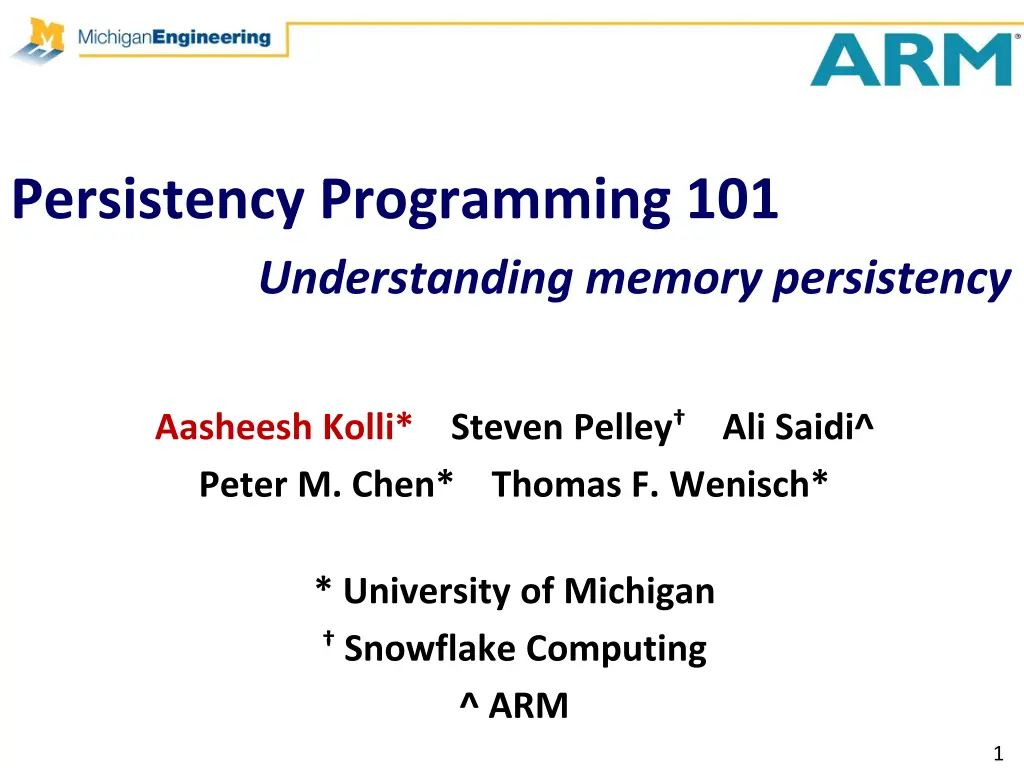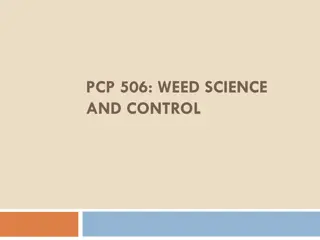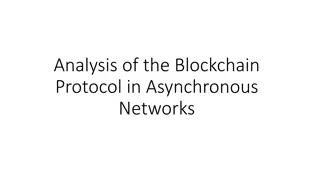
Understanding Memory Persistency in Programming 101
Dive into the world of memory persistency programming with insights on NVMs, memory consistency, persistency models, and their impact on system performance and reliability.
Download Presentation

Please find below an Image/Link to download the presentation.
The content on the website is provided AS IS for your information and personal use only. It may not be sold, licensed, or shared on other websites without obtaining consent from the author. If you encounter any issues during the download, it is possible that the publisher has removed the file from their server.
You are allowed to download the files provided on this website for personal or commercial use, subject to the condition that they are used lawfully. All files are the property of their respective owners.
The content on the website is provided AS IS for your information and personal use only. It may not be sold, licensed, or shared on other websites without obtaining consent from the author.
E N D
Presentation Transcript
Persistency Programming 101 Understanding memory persistency Aasheesh Kolli* Steven Pelley Peter M. Chen* Thomas F. Wenisch* Ali Saidi^ * University of Michigan Snowflake Computing ^ ARM 1
Executive summary NVMs -> in-memory, recoverable data structs Require ordering of NVM writes (persists) Consistency models do not order persists Memory persistency [ISCA 14] Consistency models for NVM This talk: Motivate memory persistency Summarize persistency models 2
Background - Memory consistency Contract b/w hardware and software on store visibility (implementation independent) May be strict (SC) or relaxed (RMO) Consistency spectrum Does not apply to persists Need persistency models to order persists 3
Future system abstraction Memory events (stores/loads/barriers) Core0 Core1 Core0 Core1 1 1 2 2 Persistency model governs store visibility in the presence of failures 3 3 4 4 5 5 6 6 Recovery Time No Failures Failures Volatile memory order (consistency model) Persist memory order (persistency model) 4
Types of persistency models Memory events (stores/loads/barriers) Core0 Core1 Core0 Core1 Core0 Core1 1 1 1 2 2 2 3 3 3 4 4 4 5 5 5 6 6 6 Relaxed persistency Strict Consistency persistency 5
Strict vs relaxed persistency Strict persistency Consistency model = persistency model Expensive (cost of persist > cost of store) Relaxed persistency Separate consistency and persistency models Reduces persist memory order constraints Might require more robust recovery software Failures are infrequent recovery overhead OK Relaxed persistency models performance 6
How do persists affect performance? Persists form a directed acyclic graph (DAG) Critical path limits overall performance D[0] D[0] D[1] 1: persist Qe.data[0] = x 2: persist Qe.data[1] = y 3: persist Qe.valid = true D[1] V V Models should allow expression of minimal constraints 7
Strict persistency Consistency model = persistency model Two sources of persist concurrency: Use a relaxed memory consistency model Multi-threading 8
Strict persistency with SC 1. lock (volatile mutex) 2. persist Qe.data[0] = x 3. persist Qe.data[1] = y 4. persist Qe.valid = true 5. unlock D[0] D[1] V Program order => persist order No annotations required Suboptimal persist critical paths 9
Strict persistency with RMO 1. lock (volatile mutex) 2. barrier 3. persist Qe.data[0] = x 4. persist Qe.data[1] = y 5. barrier 6. persist Qe.valid = true 7. barrier 8. unlock D[0] D[1] V Barriers for synchronization and recovery Annotation burden on the programmer Affects volatile perf 10
Relaxed persistency models Decouple consistency and persistency models Expose additional persist concurrency Important for conservative consistency models Will use SC as underlying consistency model 11
Epoch persistency 1. lock (volatile mutex) 2. persist Qe.data[0] = x 3. persist Qe.data[1] = y 4. persist barrier 5. persist Qe.valid = true 6. unlock D[0] D[1] Epoch 1 Epoch 2 V Persist barriers divide program into epochs Persists within epoch concurrent Persists from successive epochs ordered Store visibility still dictated by program order 12
Epoch persistency drawback DAG-2 Ideal DAG-1 persist A persist barrier persist C persist B persist A persist barrier persist B persist C persist A persist C persist barrier persist B persist C persist A persist barrier persist B persist A persist B persist C A A A C C B B C B Cannot express minimal constraints 13
Strand persistency Divide thread s execution into strands A strand can be abstracted as a logical thread Persists on different strands are concurrent New memory event newStrand Persist barriers order persists within a strand persist A persist barrier persist B newStrand persist C A C B Can enforce only the necessary constraints 14
Ordering persists across threads Conflicting accesses establish persist order Two accesses to same address, at least one store Persist order must match volatile order Could be to volatile/non-volatile addresses Strong persist atomicity 15
Strong persist atomicity example Thread - 1 Thread - 2 lock X (volatile mutex) persist barrier persist A persist barrier unlock X Persist order Conflicting accesses lock X persist barrier persist B persist barrier unlock X Time 16
Conclusions Strict persistency Unifies consistency and persistency model Epoch persistency Persists within epoch concurrent, epochs ordered Strand persistency Allows enforcing only minimal constraints Strong persist atomicity Allows ordering persists across threads 17
Thank You! Questions? 18
Persistency terminology Memory events: Stores/loads/barriers Failure abstracted as recovery observer Atomically loads all of memory at failure Volatile memory order Partial order of memory events Governs visibility of stores to all processors Persist memory order Governs visibility of persists w.r.t recovery observer 19
Persist ordering constraints Persists form a directed acyclic graph (DAG) Critical path limits overall performance Remove unnecessary ordering constraints Requires an interface to describe constraints 1: Persist data[0] 2: Persist data[1] 3: Persist flag Program order implies unnecessary constraints 1 2 3 20
Background Memory consistency Contract b/w hardware & software regarding visibility of stores Implementation independent Relaxed models improve store/load concurrency (performance) However, do not extend to memory Cache evictions Memory controller optimizations 21
Strict persistency Persist memory order = volatile memory order Order of persists matches store visibility Strict persistency with SC/TSO Program order => persist order No annotations necessary Restrictive, suboptimal performance Strict persistency with RMO Program order + memory barriers => persist order Need barriers to ensure correct store visibility and recovery correctness 22
Strict persistency Task: persist data then persist flag RMO SC lock (volatile mutex) persist data[0] persist data[1] persist flag unlock lock (volatile mutex) barrier persist data[0] persist data[1] persist data[N] barrier persist flag barrier unlock (volatile mutex) 23
Epoch persistency Persist barriers divide program into epochs Persists within epoch concurrent Program order => Store visibility Program order + persist barriers => Persist order lock (volatile mutex) persist data[0] persist data[1] persist data[N] persist barrier persist flag Unlock Epoch persistency improves persist concurrency 24
Nonvolatile memory (NVM) recovery Future systems will have NVM on memory bus In-memory, recoverable data structures Recovery needs NVM write (persist) ordering Writes unordered Need a mechanism to express order of persists 25
Memory persistency: consistency models for NVRAM Framework to reason about persist order while maximizing concurrency [ISCA 14] Persistency models may be strict or relaxed This talk: Primer on persistency models Discussion on achieving desired order of persists 26
Outline Background Strict persistency Epoch persistency Strand persistency Multi-threaded persist ordering 27
Executive summary NVMs -> in-memory, recoverable data structs Require ordering of NVM writes (persists)) Consistency models govern visibility of stores Do not extend guarantees to persists Might want order of stores and persists to differ Memory persistency [ISCA 14] Consistency models for NVM This talk: Summary of persistency models Example illustrating use of persistency models 28
Epoch persistency drawback Persist barriers some times cause unnecessary persist order constraints Task: persist A, then persist B, persist C not ordered persist A persist barrier persist B persist C Unnecessary constraint: A->C persist A persist C persist barrier persist B Unnecessary constraint: C->B 29
Future system abstraction Processors 3 Memory events (stores/loads/barriers) Volatile memory order (consistency model) 2 1 Caches (unordered) Recovery observer (atomically loads Mem @Failure) 2 Persist memory order (persistency model) 1 3 NVM 30
Why two different models? Consistency and persistency time scales differ Cache access (10s ns) vs NVM write (100s ns) Used for different purposes Consistency -> synchronization correctness Persistency -> recovery correctness Unified model works (strict persistency), but Must ensure correct synchronization & recovery Suboptimal performance Separate consistency and persistency models improve performance 31
Future system abstraction Pre-failure Post-failure Memory events (stores/loads/barriers) Core0 Core1 2 Volatile memory order (consistency model) 3 1 Memory cntrl Persist memory order (persistency model) Recovery processor (can only access contents of NVM) 2 1 3 NVM 32
Future system abstraction Memory event on volatile address Memory event on non-volatile (persistent) address Time Pre-failure Post-failure Core0 2 3 4 2 3 Core1 1 5 6 1 6 Store visibility (consistency model) Persist order (persistency model) 33
Future system abstraction Memory events (stores/loads/barriers) Time Core0 2 3 4 Store visibility (consistency model) Core1 1 5 6 No Failures Core0 2 3 4 Persist order (persistency model) Core1 1 5 6 Failures 34
Future system abstraction Memory events (stores/loads/barriers) Time Core0 2 3 4 Store visibility (consistency model) Core1 1 5 6 No Failures Failures Core0 2 3 4 Persist order (persistency model) Core1 1 5 6 35
Future system abstraction Memory events (stores/loads/barriers) Time Core0 2 3 4 Store visibility (consistency model) Core1 1 5 6 No Failures Failures Core0 2 3 4 Persist order (persistency model) Core1 1 5 6 Persistency model governs store visibility across failures 36






